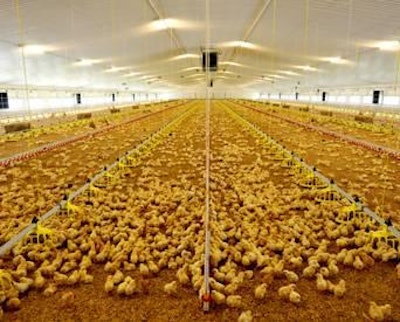
Broiler meat production in the UK grew by 4 percent last year to reach 1.372 million metric tons. Yet UK poultry producers faced many challenges in 2013, most significantly periods of financial losses, as they were not always able to achieve the price increases needed to cover production and feed costs.
According to the National Farmers Union (NFU), there was market resistance to price increases for poultry, however, the situation improved somewhat by the autumn for producers when feed prices started to fall.
The year end -- particularly the months of November and December -- are generally a difficult trading time for broiler meat in the UK, but as 2013 drew to a close, the NFU found that the market had held out well.
The British Poultry Council (BPC) also confirms that, overall, the market in 2013 was good.
The fall in feed prices and growing demand for locally produced food has led the NFU to predict that, this year, there will be a further increase in poultry meat production, which is expected to reach 1.4 million metric tons, or a 3 percent expansion.
Move toward British poultry
Poultry meat remains one of the most popular meats in the UK. The country is home to 2,500 poultry farms. Ninety-five percent of birds are reared indoors, 4.5 percent are free range and 0.5 percent are organic. For the 873 million birds that were slaughtered in 2012, there are 30 processing plants, handling 1.3 million metric tons of broilers.
However, the UK remains a significant importer. In addition to home produced meat, the UK consumed 600,000 metric tons of imported poultry meat in 2012, mainly in the form of frozen white meat cuts for food service. This imported meat offers a significant opportunity for UK producers to substitute, particularly in view of changing consumer attitudes.
The popularity of chicken meat has grown, particularly as a result of the horsemeat scandal, which has had the further effect of pushing people to favor home-produced meat. Research carried out by the NFU has found that consumers are more likely to look for and buy British produce since the horsemeat scandal.
UK retailers are responding to this change in consumer attitudes and this is already benefitting the country's poultry producers.
Supermarket chain Tesco, for example, switched to 100 percent fresh UK chicken for its UK outlets last July. This is thought to have boosted demand for British poultry by 600,000 birds per week.
The company is also making progress in switching to British poultry for its ready meals and frozen ranges.
The challenge going forward is ensuring the sources of all ready meals and frozen are from the UK, the NFU says.
Love Chicken
To further encourage consumers to buy British, the NFU has launched the online Love Chicken site, to make people think about buying quality mark Red Tractor chicken. Many organizations and individuals are backing the campaign, including Manchester United, Waitrose, Tesco, Brakes and Compass, and the NFU hopes to develop these links even more.
However, one of the main challenges facing the UK poultry sector is high volume production, with small margins, and no subsidies, so poultry producers are arguing for support from all stakeholders to ensure fair returns for producers and affordable meat for consumers.
Global market prices
Part of the challenge, says the BPC, is the cost of feed, which accounts for 50 percent of the cost of an oven-ready chicken. This is partly due to the global price volatility for feed, making it hard for the industry to cope with price rises, and it is important that the industry and stakeholders work together with retailers to mitigate these costs, the NFU argues.
The UK poultry industry still relies on imported soya as a source of protein. This is, from a strategic, financial and environmental aspect, not sustainable. According to the NFU, increasingly maize is being used in poultry rations as a substitute to wheat at an inclusion rate of up to 10 percent, yet other solutions are needed.
The organization is campaigning for legislation to be passed at European level to allow meat and bone meal to be used in poultry rations as birds are natural omnivores. Meat and bone meal would significantly reduce the UK's reliance on imported soya and would be a good example of recycling, it notes
Controlling Campylobacter
Another challenge facing producers is Campylobacter, not in terms of its impact on chicken health but in terms of the effect it may have on consumer demand.
The NFU says that reducing levels of Campylobacter food poisoning is the number one priority of the UK's Food Standards Agency (FSA), and it is participating in the agency's Joint Working Group on Campylobacter.
NFU representatives have met privately with Catherine Brown, CEO of the FSA, on a number of occasions to discuss reducing levels of Campylobacter on live birds and poultry meat, and has appointed a graduate to work on a three-month project to look at what all stages of the food chain can do to reduce the risk of food poisoning. The project will include how to reinforce the message to the consumer of the need to correctly handle, store and to thoroughly cook poultry meat.
The NFU is also in regular contact with its members to update them on the latest technologies and developments in reducing Campylobacter and continues to reinforce the need to maintain high biosecurity levels.

















